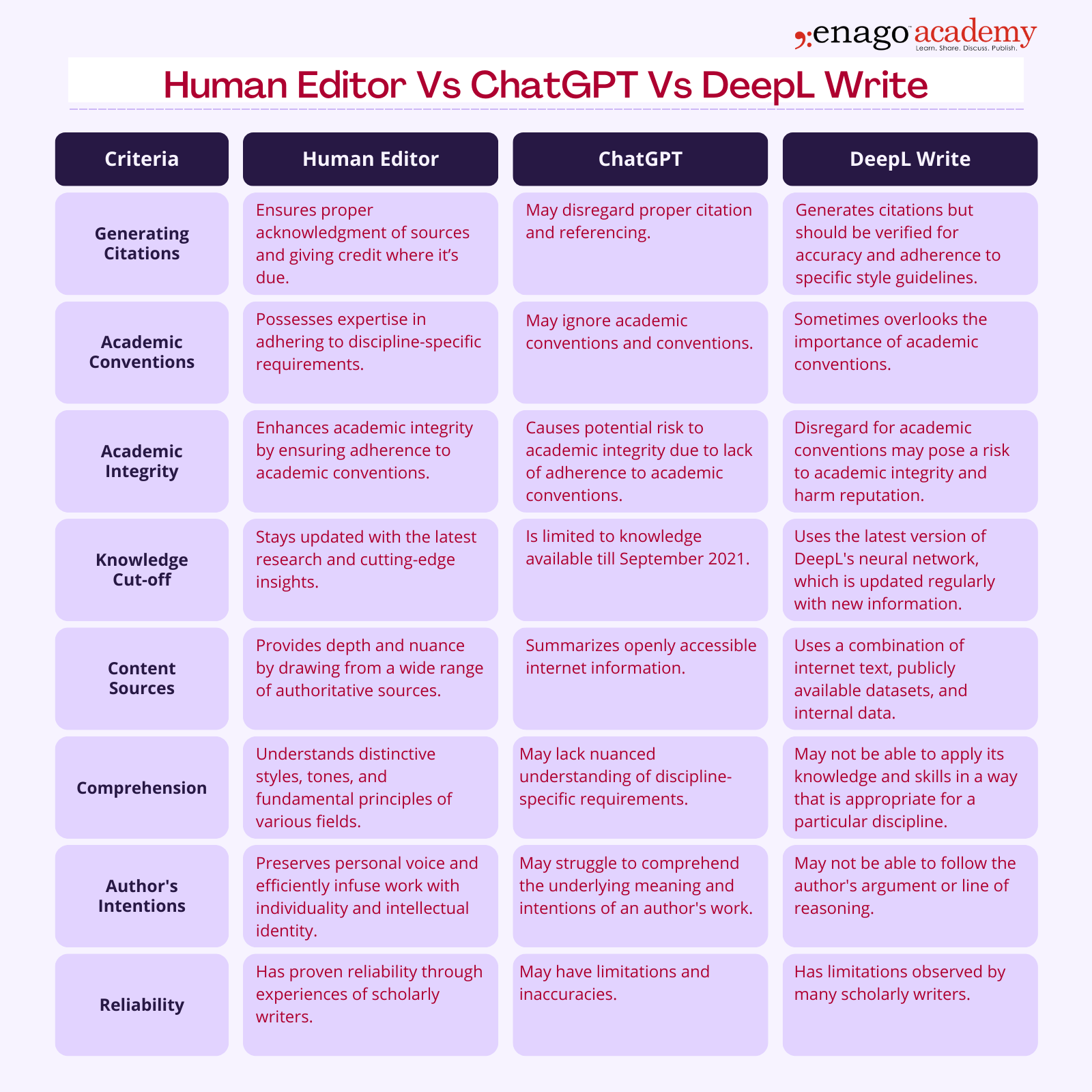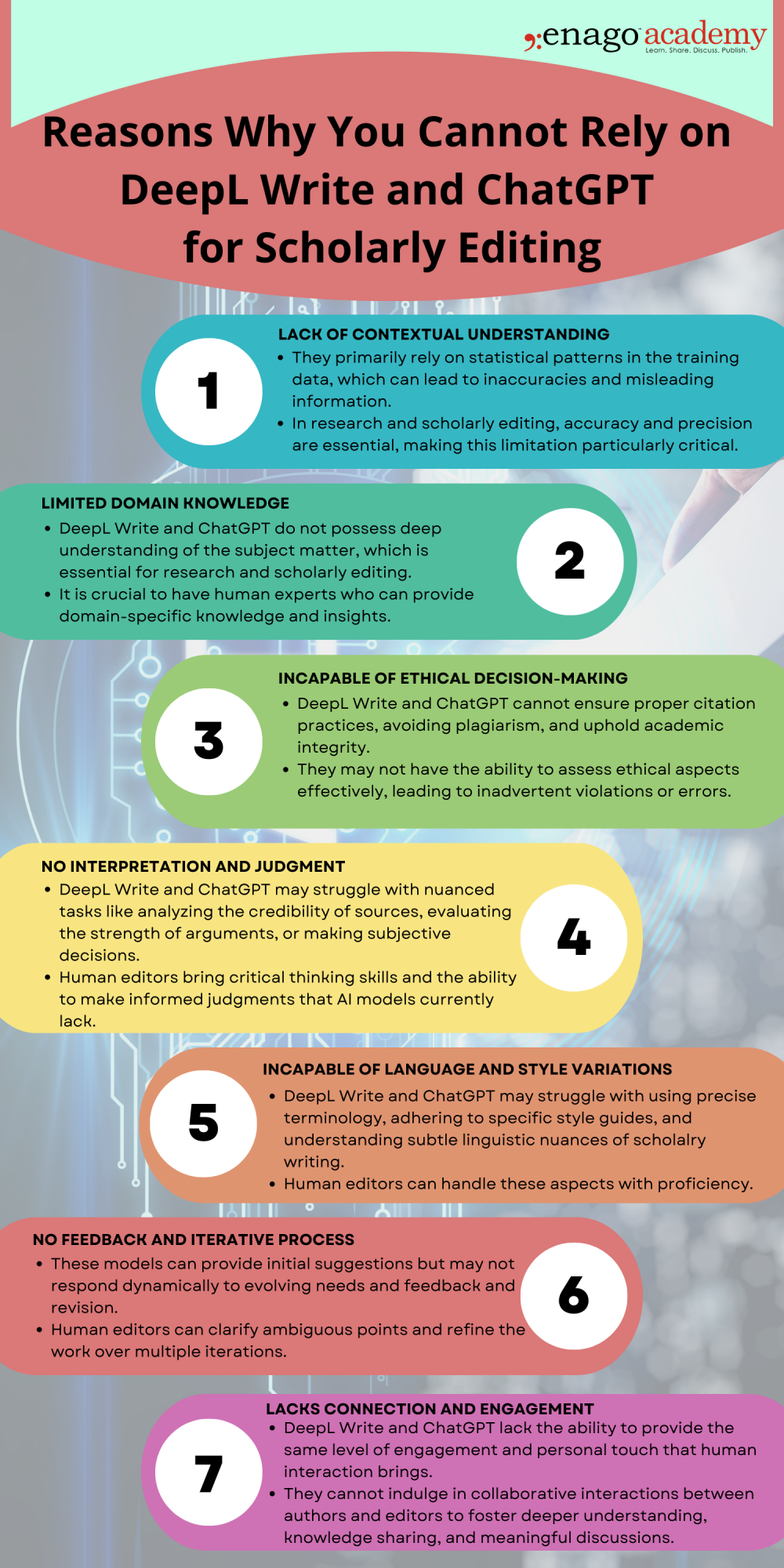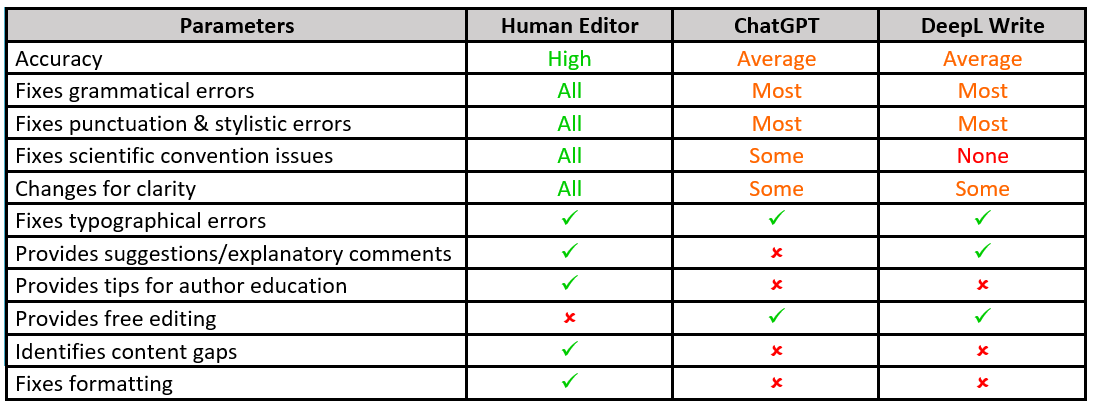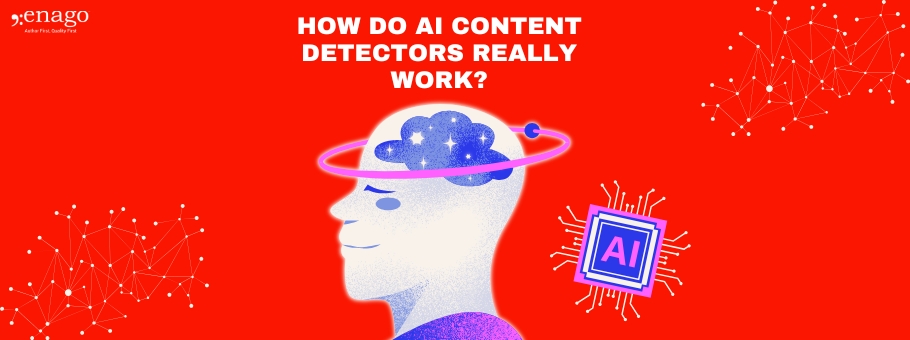Limitations of DeepL Write and ChatGPT in Scholarly Editing: How human editors overpower AI tools

Complete reliance on AI, such as DeepL Write and ChatGPT, for research and scholarly editing is not feasible or advisable.
When editing your scholarly work, the choice among DeepL Write, ChatGPT, and human editors can greatly impact your academic reputation.
Human Editor Vs ChatGPT Vs DeepL Write: Comparison of different aspects
 Why You Cannot Rely on DeepL Write and ChatGPT for Academic Editing
Why You Cannot Rely on DeepL Write and ChatGPT for Academic Editing
AI technologies may have made significant advancements in natural language processing (NLP) and machine learning (ML), there are several reasons why relying solely on AI tools like DeepL Write and ChatGPT for these tasks may not be the best approach.
 While these technologies have demonstrated remarkable capabilities in natural language processing, they have notable limitations in research and scholarly editing.
While these technologies have demonstrated remarkable capabilities in natural language processing, they have notable limitations in research and scholarly editing.
DeepL Write and ChatGPT can support several tasks by providing initial suggestions and automating certain processes; however, human editors remain indispensable for ensuring accuracy, critical thinking, ethical standards, and meaningful engagement.
Examples and Error Explanations of DeepL Write Vs ChatGPT Vs Human Editing
Example 1
Original Text

Edited by DeepL Write

Edited by ChatGPT

Edited by a Human (Enago Editor)
 Error Explanation
Error Explanation
The human editor combined the two sentences with the use of technical jargon. In contrast, the ChatGPT & DeepL Write sentences could not revise “stock pays no dividend” and “switching geometric Brownian motion” to “no-dividend stock” and “regime-switching geometric Brownian motion”, respectively.
Example 2
Original Text

Edited by DeepL Write

Edited by ChatGPT

Edited by a Human (Enago Editor)
 Error Explanation
Error Explanation
In the second sentence, the author is referring to Renaissance and not Renaissance art; Renaissance began in Italy before it spread to the Low Countries. This was not fixed by both ChatGPT & DeepL Write.
Example 3
Original Text

Edited by DeepL Write

Edited by ChatGPT

Edited by a Human (Enago Editor)
 Error Explanation
Error Explanation
The author had incorrectly spelt out nephrectomy as necrotomy and ChatGPT & DeepL Write were unable to catch and fix that even though the entire abstract was given for editing. Further, DeepL Write revised “necrotomy” to “necropsy” which is even worse.
These observations highlight the limitations in the capabilities of ChatGPT & DeepL Write, leading to the inference that these language models have difficulty in accurately editing scholarly work.
Comparative Analysis of Human Editing Vs ChatGPT Vs DeepL Write Editing

Balancing Human and Artificial Intelligence in Scholarly Editing
Achieving a balance between AI and human involvement in research and scholarly editing is crucial to leverage the strengths of both approaches while mitigating their limitations. Moreover, by combining the capabilities of AI technologies with human expertise, critical thinking, and judgment, it is possible to enhance the quality, efficiency, and effectiveness of these processes.
1. Proofreading and Grammar Checking
- Use AI tools like DeepL Write and ChatGPT to quickly identify and correct errors in grammar, spelling, and punctuation of general writing.
- Review and double-check the AI-generated suggestions to ensure accuracy and context appropriateness.
- Furthermore, pay attention to their recommendations for sentence structure and clarity, as they could change the author’s voice and messaging.
2. Language Translation
- Utilize DeepL Write for quick translations of research papers or scholarly articles.
- Review and refine the DeepL Write generated translations for accuracy and nuances specific to the target language and subject area.
- Use DeepL Write translation as a starting point, but rely on human editors for final polishing and ensuring the translated text maintains coherence and clarity.
3. Citation Formatting
- Take advantage of these AI tools to automatically format citations.
- Verify the accuracy and completeness of the citations generated with the help of DeepL Write, ChatGPT, or any other AI tool by cross-referencing them with official style guides or manuals.
- Moreover, familiarize yourself with these tools’ formatting capabilities and any specific requirements or limitations it may have for citation formatting.
4. AI-assisted Data Analysis
- Process large datasets and identify patterns, correlations, and trends that may be challenging to detect manually.
- Verify the results and insights through statistical analysis and validation techniques.
- In addition, combine insights by DeepL Write and ChatGPT with human interpretation and expertise to draw meaningful conclusions and make evidence-based decisions.
5. Contextual Understanding and Interpretation
- Collaborate with human experts who possess domain-specific knowledge to ensure accurate interpretation of research findings.
- Also, engage in discussions and seek clarifications from authors or researchers to grasp complex concepts and contextual information.
- Finally, consider historical, cultural, and social contexts while interpreting and evaluating the relevance and integrity of the research.
6. Ethical Considerations and Bias
- Maintain a thorough understanding of ethical guidelines and academic integrity standards to detect and address potential ethical issues.
- Use DeepL and ChatGPT to identify potential instances of plagiarism or improper citation, but rely on human editors to evaluate the context and intent.
- Be vigilant in recognizing and mitigating biases, both in the research content and within the AI tools themselves (after all, they are all trained on almost the same data!).
7. Collaboration and Engagement
- Actively engage with authors, researchers, and peers throughout the editing process to foster collaboration and effective communication.
- Seek constructive feedback and guidance from human editors to enhance your work and consider diverse perspectives.
- Additionally, use collaborative platforms and tools that facilitate real-time communication and document sharing to streamline the editing workflow.
8. Critical Thinking and Creativity
- Emphasize critical analysis and creative problem-solving during the editing process to generate original ideas and insights.
- Challenge the suggestions given by DeepL Write and ChatGPT, and explore alternative approaches to strengthen arguments and enhance your research’s impact.
- Additionally, think critically and contribute your unique perspectives, ensuring that the research goes beyond automated text generation.
By combining the strengths of AI and human editors, we can optimize the quality, integrity, and impact of research and scholarly editing, while ensuring that human expertise and judgment remain at the forefront.
Salient Insight on Human Editing Vs DeepL Write Vs ChatGPT
Finally, although ChatGPT and DeepL Write have made notable advancements in natural language processing, the observations provide strong evidence of their limitations in accurately editing scholarly work. Furthermore, these tools fail to correct technical jargon, understand context, rectify typos, produce concise and clear sentences, and grasp domain-specific knowledge.
They may misinterpret or overlook crucial errors, leading to inaccuracies or further mistakes in their generated edits.
On the other hand, human editors proficiently edit and revise scholarly work with their unparalleled expertise, and thus continue to remain indispensable against AI tools like DeepL Write and ChatGPT.









A very interesting piece and views shown – especially the limitations of ChatGPT and DeepL Write cf human editing. One area it doesn’t consider is the negative aspect of inflicting ChatGPT/DeepL Write on editors for further editing.